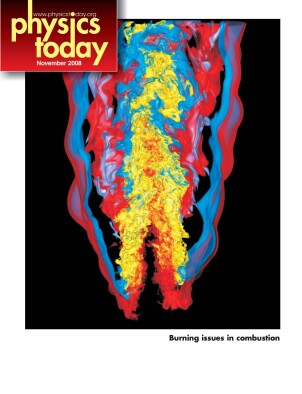Flapping flags in tandem
DOI: 10.1063/1.3028002
Racing cars and bicycles—and even lobsters migrating along the ocean floor and ducklings swimming behind their mother—can reduce the effects of drag by following closely behind a leader. But those objects all have fixed shapes, and new work shows that such conventional fluid drafting, or slipstreaming, is reversed for undulating objects. Inspired by schooling fish and flocking birds, Leif Ristroph and Jun Zhang studied how flapping flags change the fluid drag forces on one another when grouped together in a flowing fluid. To their surprise, they discovered that it is the leading flag that enjoys a drag reduction—up to 50%—while its downstream neighbor can experience a significant drag increase.
This image shows the wake of two tandem, one-dimensional threads flapping in the breeze of a two-dimensional flowing soap film. The wake is visualized using thin-film interferometry. The threads, 2 cm long, are fixed at their upstream ends and separated here by a distance 60% of their length. In this configuration, the drag on the front flag is reduced from that on an isolated flag by about 20%; that on the downstream flag is increased by 50%. For smaller separations, the drag on both flags decreases. The researchers find that the leader’s drag reduction persists if the follower is shifted laterally by half a body length or more. If inverted drafting extends to fish schools and bird flocks, the leaders would also have a reduced burden and spend less energy as they swim or fly.
To submit candidate images for Back Scatter, visit http://www.physicstoday.org/backscatter.html

L. Ristroph, J. Zhang,





